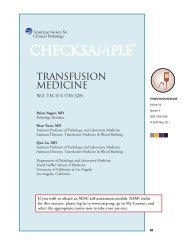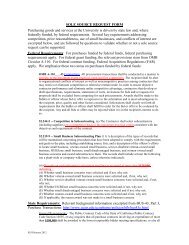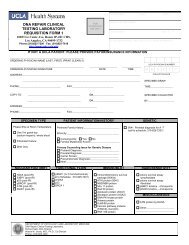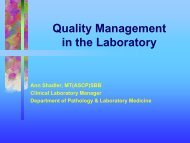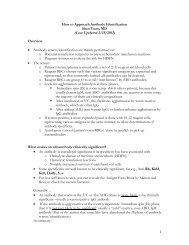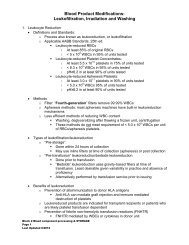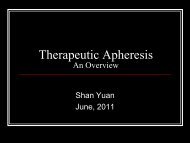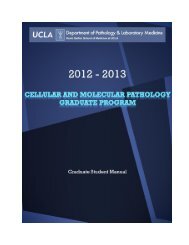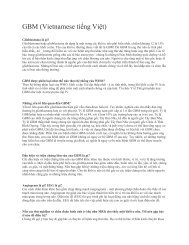Duffy, MNS and Gerbich Blood Group Antigens. By Q Lu - the UCLA ...
Duffy, MNS and Gerbich Blood Group Antigens. By Q Lu - the UCLA ...
Duffy, MNS and Gerbich Blood Group Antigens. By Q Lu - the UCLA ...
Create successful ePaper yourself
Turn your PDF publications into a flip-book with our unique Google optimized e-Paper software.
<strong>Blood</strong> <strong>Group</strong>s – <strong>Duffy</strong>, <strong>and</strong><br />
<strong>MNS</strong>s <strong>Group</strong> Systems<br />
Qun <strong>Lu</strong>, MD<br />
Assistant Professor<br />
Division of Transfusion Medicine<br />
Department of Pathology <strong>and</strong> Laboratory Medicine<br />
<strong>UCLA</strong>, School of Medicine<br />
Los Angeles, California<br />
2009-03-12
<strong>Duffy</strong> <strong>Blood</strong> <strong>Group</strong> System
History<br />
• 1950: Mrs. <strong>Duffy</strong>, a multiply transfused hemophiliac<br />
woman, developed an antibody not reacting with <strong>the</strong><br />
known RBC antigens. Corresponding antigen was<br />
named after Mrs. <strong>Duffy</strong><br />
• 1951: Fyb antibody was described in a woman with<br />
3 pregnancies.<br />
• 1955: Majority of blacks tested Fy(a-b-)<br />
• 1975: Fy(a-b-) RBCs were shown to resist infection<br />
by malaria organism Plasmodium vivax.<br />
• Later: more <strong>Duffy</strong> antigens (Fy3, Fy4, Fy5, Fy6)<br />
were discovered<br />
• ISBT: 008 for <strong>the</strong> <strong>Duffy</strong> <strong>Blood</strong> <strong>Group</strong>
<strong>Duffy</strong> <strong>Antigens</strong><br />
• Most common: Fya <strong>and</strong> Fyb.<br />
• Present at 6 weeks of gestation, well developed at birth – anti-<br />
Fy can cause hemolytic disease of newborn<br />
• <strong>Duffy</strong> antigens can be destroyed by enzymes such as ficin,<br />
papain, bromelain, chymotrypsin, ZZAP<br />
• When compared to Rh or Kell antigens, <strong>Duffy</strong> antigens are not<br />
very immunogenic. So, anti-Fya or anti-Fyb is not common.<br />
• Fy (a-b-) is not Fy null, but homozygous for Fy b gene, <strong>the</strong>y<br />
express Fyb antigen in o<strong>the</strong>r tissues, but not on RBCs → only<br />
will produce anti-Fy a , not anti-Fy b .<br />
• Fy (a-b-) is negative for Fy 6 antigen which is <strong>the</strong> receptor for P.<br />
vivax (Fy 6 is + when Fy a + or Fy b +)
<strong>Duffy</strong> <strong>Antigens</strong><br />
• Phenotype Frequencies<br />
Phenotype Whites % Blacks % Chinese<br />
%<br />
Fy (a+b-) 17 9 90.8<br />
Fy (a+b+) 49 1 8.9<br />
Fy (a-b+) 34 22 0.3<br />
Fy (a-b-) rare 68 0<br />
Fya: 66% Caucasians, 10% Blacks, 99% Asians<br />
Fyb: 83% Caucasians, 23% Blacks, 18.5% Asians<br />
Fy3: 100% Caucasians, 32% Blacks, 99.9% Asians<br />
White donor population:<br />
Fya – units: 35%<br />
Fyb – units: 15%
<strong>Duffy</strong> <strong>Antigens</strong><br />
• Biochemistry: glycoprotein, transmembrane (7<br />
times, 3 extracellular loops)<br />
• Function: amino acid is similar to interleukin -8<br />
receptor on WBCs, receptors of cytokines<br />
• Gene: chromosome 1q22-23. Rh gene also<br />
located on chromsome 1, but not linked<br />
• Fyx gene: produced weak Fyb antigen – react with<br />
some not all anti-Fyb, it can be typed as Fy(b-),<br />
can cause confusion in paternity testing
Chromosome 1q22-23
REVIEW ARTICLE<br />
• <strong>Blood</strong>, Vol. 89 No. 9 (May 1), 1997: pp. 3077-<br />
3091<br />
• From Malaria to Chemokine Receptor: The<br />
Emerging Physiologic Role of <strong>the</strong> <strong>Duffy</strong> <strong>Blood</strong><br />
<strong>Group</strong> Antigen<br />
• <strong>By</strong> Terence J. Hadley <strong>and</strong> Stephen C. Peiper<br />
• From <strong>the</strong> Departments of Medicine, Pathology,<br />
<strong>and</strong> Biochemistry, Henry Vogt Cancer Research<br />
Institute, James Graham Brown Cancer Center,<br />
University of Louisville; <strong>and</strong> <strong>the</strong> Department of<br />
Veterans Affairs Medical Center, Louisville, KY.
This thin film Giemsa stained micrograph reveals a mature Plasmodium vivax<br />
trophozoite.<br />
P. vivax trophozoites show amoeboid cytoplasm, large chromatin dots, <strong>and</strong> fine,<br />
yellowish-brown pigment. RBCs are enlarged 1 1/2 - 2X, <strong>and</strong> may be distorted. If visible,<br />
Schüffner's dots may appear finer than those seen in P. vivax.
Anti-Fya <strong>and</strong> Anti-Fyb<br />
• IgG, clinically significant, warm-reacting, exposurerequiring<br />
antibody<br />
• Transfusion reactions: acute or delayed hemolytic<br />
transfusions<br />
• HDN cases are usually mild<br />
• Anti-Fya is more common than anti-Fyb (Fya is more<br />
immunogenic than Fyb)<br />
• Anti-Fya or anti-Fyb do not react with enzyme treated<br />
RBCs (useful tech in ID)<br />
• Dosage effect is not as strong as anti-Jk<br />
• Antibody titers can fade over time, causing delayed<br />
hemolytic transfusion reaction<br />
• People with Fy (a-, b-) phenotype can make anti-Fy3<br />
(anti-Fy a & anti-Fy b reactivity)
Uncommon <strong>Duffy</strong> Antigen <strong>and</strong><br />
Antibody<br />
• Fy3: 1971 a case reported that anti-Fy3 was found<br />
in an Fy(a-b-) white. It reacted with all RBCs<br />
except Fy(a-b-) cells. Fy3 antigen is part of <strong>the</strong><br />
Fya <strong>and</strong> Fyb antigen (one of <strong>the</strong> 3 extracelluar<br />
loops)<br />
• Fy4: 1973 a Fy(a+b+) black made anti-Fy4<br />
reacted with all Fy(a-b-) blacks, Fy(a+b-), <strong>and</strong><br />
Fy(a-b+) blacks, but not with Fy(a+b+) blacks <strong>and</strong><br />
not with whites of any <strong>Duffy</strong> type. Fy(a-b-) blacks<br />
carry Fy4Fy4 antigens
Uncommon <strong>Duffy</strong> Antigen <strong>and</strong><br />
Antibody<br />
• Fy5: 1973 an Fy(a-b-) black child made anti-Fy5<br />
which reacted with cell from a Fy(a-b-)Fy3-, but<br />
did not react with Fy(a+) or Fy(b+) Rh null red cells.<br />
Fy5 antigen is <strong>the</strong> result of <strong>Duffy</strong> <strong>and</strong> Rh genes<br />
• Fy6: 1987, marine monoclonal antibody, much like<br />
anti-Fy3, but destroyed by enzymes (Fy3, Fy4,<br />
Fy5 antigens resist enzymes). Fy6 is <strong>the</strong> receptor<br />
for P. vivax <strong>and</strong> present on all Fy + cells.
<strong>MNS</strong>s (002) <strong>Blood</strong> <strong>Group</strong><br />
System
<strong>MNS</strong>s <strong>Antigens</strong><br />
• Total 46 antigens<br />
• Antigen Biochemistry:<br />
– Glycophorin A (GPA) forms <strong>the</strong> M, N antigens<br />
– Glycophorin B (GPB) forms <strong>the</strong> S, s antigens <strong>and</strong> U antigen.<br />
U antigen is <strong>the</strong> common core of S, s antigens<br />
– The glycophorins cross <strong>the</strong> RBC membrance once <strong>and</strong> have<br />
an external N-terminal <strong>and</strong> a intracellular C-terminal (linked<br />
to spectri skeleton)<br />
– GPA (1 million copies) is much more abundant than GPB<br />
(200,000 copies)<br />
• Tight linkage between GPA <strong>and</strong> GPB<br />
• GPA is an erythroid marker <strong>and</strong> is <strong>the</strong> receptor for<br />
Plasmodium falciparum<br />
• M antigen is receptor of E. coli
AABB Technical Manual, 14th Edition, Page 320
<strong>MNS</strong>s <strong>Antigens</strong><br />
• Destroyed by common enzymes (Papain, Ficin,<br />
Bromelin, Pronase), but U antigen is resistant<br />
• Trypsin: M, N sensitive, S, s resistant<br />
• Alpha-chymotrypsin: M, N partialy sensitive, S, s<br />
very sensitive<br />
• S-s-U- phenotype: 2% of Black American <strong>and</strong> a<br />
higher propotion of Black African, due to deletion<br />
of <strong>the</strong> GPB gene, will produce anti-S, s, U<br />
• S- units in White donors: 50%<br />
• S- units in White donors: 10%
<strong>MNS</strong>s Antibodies<br />
• Anti-M, anti-N: IgM, insignificant, cold-reacting, naturally<br />
occurring. Anti-M is common, but anti-N is rare<br />
• When anti-M, anti-N is reactive at 37C, antigen negative units<br />
should provided<br />
• Rare case of anti-M associated severe HDFN has been<br />
reported:<br />
– Lost 2 previous pregnancies, <strong>the</strong> third baby survived because of<br />
intrauterine transfusion<br />
– Fetus ruled out o<strong>the</strong>r causes of hemolysis<br />
– M+ radio-labled RBCs were destroyed withing 3days after transfusion<br />
– M- radio-labled RBCs survived 30days after transfusion to <strong>the</strong> mo<strong>the</strong>r<br />
(anti-M +).<br />
• Rare case of auto-anti-N causing fatal autoimmune hemolytic<br />
anemia<br />
• Anti-N is associate with hemodialysis, because N antigen is<br />
modified by formaldehyde in <strong>the</strong> dialysis machine.
<strong>MNS</strong>s Antibodies<br />
• Anti-S, anti-s, & anti-U: IgG, significant,<br />
warm-reacting, exposure-requiring<br />
• Whites – 100% S+, s+,1% of blacks-- S-, s-,<br />
<strong>and</strong> U- (make anti-U)<br />
• GP.Mur phenotype in Sou<strong>the</strong>ast Asia: hybrid<br />
gene of GPA <strong>and</strong> GPB produce an unusual<br />
amino acid sequence (antigen Mur =<br />
<strong>MNS</strong>10), immunogenic.<br />
• Anti-Mur is <strong>the</strong> most common antibody after<br />
anti-A <strong>and</strong> anti-B in Hong Kong <strong>and</strong> Taiwan
<strong>Gerbich</strong> System<br />
• <strong>Antigens</strong>:<br />
– Located on Glycophorin C <strong>and</strong> D<br />
– 8 antigens, 3 high prevalence (Ge 2, 3, 4), 5 low<br />
prevalence<br />
– Glycophorin C is <strong>the</strong> receptor for P. falciparum.<br />
• Antibodies<br />
– IgG, react at AHG phase,<br />
– Clinically insignificant, but anti-Ge3 has been<br />
reported to cause HDFN, tend to manifest 2-4<br />
wks after birth
RBC <strong>Antigens</strong><br />
<strong>Duffy</strong><br />
Kidd<br />
Chido/Rodgers<br />
Knops<br />
Colton, Co a , Co b<br />
Cartwright, Yt a , Yt b<br />
Cromer<br />
MN, <strong>Gerbich</strong> antigen<br />
Functions<br />
Receptor for chemokins,<br />
plasmodium vivax<br />
RBC urea transport (not kidney<br />
urea transport)<br />
C4<br />
Receptor for C3/C4b<br />
RBC water transport<br />
RBC AchE<br />
CD55 = DAF (decay<br />
accelerating factor)<br />
Receptor for p. falciparum





